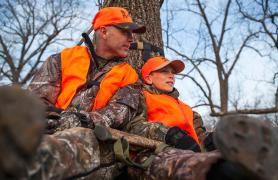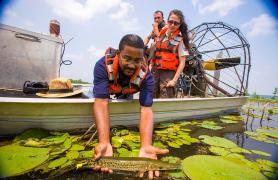Missouri’s landscape is forever changing. Since the first European settlement, Missouri’s native habitats have been altered by population expansion, the agricultural industry, the industrial age, and recreation, just to name a few. Today, competition for the finite resource we call land is fierce. So how do we carve out a place that has clean water, healthy grasslands, and abundant wildlife and remain economically sound?
We work together
Missouri is approximately 44 million acres in size. MDC manages about 1 million acres statewide, or approximately 2 percent of the state. Combine all land managed by other state and federal agencies, and that percentage climbs to around 7 percent of the total land base in public ownership. That’s not a lot of room for wildlife to flourish.
So what about the other 41 million acres? Take a trip across Missouri, and you’ll see cities and towns connected by an extensive road system lined with private land. You may notice a significant number of farms with vast fields of crops or cattle meandering in pastures. A 2016 U.S. Department of Agriculture (USDA) report found all grain crops in Missouri totaled about 14 million acres. Missouri also ranked second nationally in total number of cattle with about 69,000 cattle and hay operations.
Approximately 50 percent of Missouri’s agriculture economy is forage based, meaning we grow a lot of grass. The dominant grass on Missouri’s landscape is tall fescue, with an estimated 17 million acres, according to the University of Missouri’s Forage Systems Research Center. Though not all of that is used in cattle production or hay, it does represent a unique opportunity for conservationists and farmers to work together toward a common goal.
Tall fescue is the primary reason why Missouri can produce so many cattle, but it offers less benefit for wildlife than many of our native warm-season grasses.
MDC believes adding a diverse mixture of grasses for grazing or haying on each farm can improve cattle gains and health while offering enhanced wildlife habitat.
Getting in the Mix
It’s easy to understand why MDC would like more diverse grasslands in Missouri. Native prairies supported countless wildlife through the ages. Wildlife big and small depend on the ecological functions these areas provide for food, shelter, and sheer survival. Grassland wildlife have evolved to take full advantage of species composition, bloom times, structure, and function to sustain them. For example, MDC continues efforts to restore and manage greater prairie-chickens in select landscapes in northwest and southwest Missouri. Prairie-chickens evolved to depend on the vast grassland landscapes and as their numbers declined, they needed a helping hand to remain in Missouri. Without the assistance of private landowners in these areas, the restoration of these iconic birds would not be possible. Biologists continue to work with producers to remove trees and restore diverse native grasslands for prairie-chickens and other grassland birds.
What makes the partnership work is finding common ground.
When MDC is working to improve greater prairie-chicken habitat with producers, pasture land is converted to native mixes. The greater amount of structural diversity provides birds like greater prairie-chickens or quail the cover and nesting habitat they need. These areas generally offer increased bug diversity, a primary food source for young chicks. Without management, native grasses become too tall and thick to be useful.
Grazing is a useful tool to manage native grasses on a working farm. Cattle are used in ways that mimic the disturbances that occurred naturally with grazers like bison. Grazing creates variable vegetation heights and small areas of bare soil, which are necessary for wildlife like the greater-prairie chicken. “Warm season grasses are well-adapted to northwest Missouri’s soils and offer nutritional forage in the warmer months of June, July, and August when cool season grasses are less vigorous,” said Kendall Coleman, a private land conservationist (PLC) with MDC. “A diverse mix ensures that, regardless of the grazing period, there is something nutritional to offer that animal.”
Forming Partnerships
Partners like Robin Frank, a cattle farmer in northwest Missouri prairie chicken country, are critical to the success of restoration efforts. He helps create a bigger footprint of space that the birds can use as the population grows. Frank converted approximately 500 acres of fescue pasture to warm-season grasses with plans to convert about 20 percent of his available grazing acres to native mixes.
“Cattle do well on this summer native warm-season grass forage,” Frank said. “I have experienced improved conception rates and increased gains with this practice, compared to normal fescue pasture.”
Native grasses, though adapted to our soils and climate, do offer some challenges to producers. Establishing a healthy stand of native grass takes time and commitment to manage. Time and the loss of existing forage start to cut into the bottom line, making it a tough sell even though long-term gains may surpass the short-term losses. To help bridge that gap, PLC Dave Niebruegge teamed up with a local landowner in Pettis County to experiment with ways to minimize forage loss while establishing warm-season grasses.
Test Shows Promise
Cattle and Century Farm owner Johnie Brauer had an interest in wildlife and wanted to bring quail and rabbits back to the farm like he experienced as a child. Together, Brauer and Niebruegge worked out a plan to experiment on approximately 20 acres of the farm, incorporating annual cover crops into a native warm-season grass planting. The cover crop mix served as a nurse crop for warm-season grasses and provided supplemental forage during the establishment of native grass. As the cover crops and native grass grew alongside each other in the field, cattle grazed the new planting. The cattle favored the more robust cover crops to the newly sprouted natives, allowing them to get a good start. Cover crops have an added benefit that promote improved soil health and quality.
“The annual forages can really fill a void during the year when other perennial forages are not producing very well,” said Niebruegge.
During the first year of the experiment, calves were put into the field in August using a high-stock density/short-duration grazing method. After 30 days of grazing, calves showed an average daily gain of two pounds. According to Brauer, the cover crops helped get his cows through the summer lull and in good shape to put them in fall coolseason pastures.
Results from Brauer and Niebruegge’s experiment are still pending, but the outlook is promising. As the experiment reaches its third year, native grasses are abundant and well established. Brauer sees and hears more wildlife, like quail and rabbits, than he can remember in recent years.
“By managing the farm for wildlife, my cattle are not suffering whatsoever,” Brauer said. “I’m managing it in a way the cattle benefit, as well as the wildlife.”
Working Together
Another aspect of cattle farming is the availability of hay, an important supplement. The amount of forage available outside the growing season is critically important both economically and to the health of a cattle producer’s animals. Careful planning and record keeping help improve the family business and inform future management decisions. Just ask Jim and Mike Massman of Osage County. They were early adopters of native grass in their operation. Jim and Mike planted a 13-acre field of big bluestem in 2000 to provide quality forage for their cattle. When Jim noticed Johnson grass invading his stand of big bluestem, he reached out to PLC Seth Barrioz for assistance in 2013. As Barrioz and Jim worked together to eliminate the Johnson grass, Barrioz became more familiar with the Massmans’ operation and goals.
“While a solid stand of big bluestem is not the most beneficial from a wildlife perspective, it is a step in the right direction,” said Barrioz. “We would like to see a more diverse mix of species, but I am here to help the landowner reach their goals and keep fish, forest, and wildlife in mind.”
The Massmans have tracked their forage production, and the results are impressive. From 2009–2014, the 13-acre field of big bluestem averaged 3.8 tons per acre of hay. This includes the drought year of 2012, which produced 1.9 tons per acre that July. The Massmans’ management consists of light fertilization (60 pounds per acre) of nitrogen each year and a three-year burn rotation. Burning may seem counterintuitive to create forage, but the numbers show spikes in tonnage produced following a burn year. They have never had to replant or overseed the field.
When Jim was asked if he would have done anything differently, his only response was, “I should have planted big bluestem 20 years earlier.”
There are many more examples of MDC and landowners working together to make a difference in Missouri. The Department of Conservation continues to explore new and innovative ways to expand partnerships to ensure the longterm sustainability of Missouri’s fish, forest, and wildlife resources. Whether actively seeking the assistance of landowners to help keep remnant species on the landscape, finding ways to bridge the gap on local farms, or using natives to keep operations running efficiently, working together is essential.
Considering Missouri’s current landscape, we have an opportunity to make a difference for future generations. Working together to implement more wildlife-friendly grasses will have a profound effect on habitat in Missouri.
Not all of the 17 million acres of tall fescue in Missouri are used in cattle production or hay. But if landowners were able to change even 10 percent of that total acreage to native warm-season grasses, they could nearly double the amount of wildlife habitat MDC currently manages statewide. What a great opportunity to provide a win for Missouri’s wildlife and cattle producers.










Also In This Issue


And More...
This Issue's Staff
Associate Editor - Bonnie Chasteen
Staff Writer - Larry Archer
Staff Writer - Heather Feeler
Staff Writer - Kristie Hilgedick
Staff Writer - Joe Jerek
Creative Director - Stephanie Thurber
Art Director - Cliff White
Designer - Les Fortenberry
Designer - Marci Porter
Photographer - Noppadol Paothong
Photographer - David Stonner
Circulation - Laura Scheuler






















